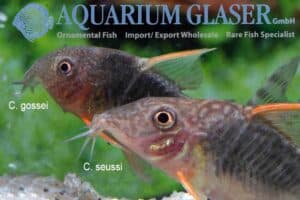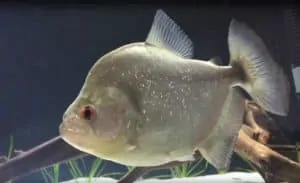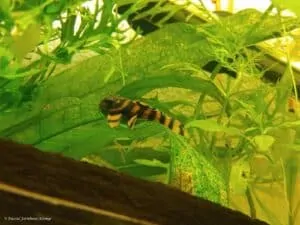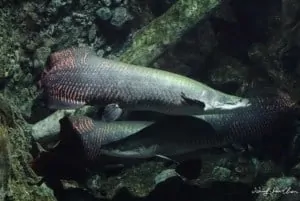Corydoras seussi
Corydoras seussi was officially described by Dinkelmeyer in 1996. It is named after the German ichthyologist Dr. Werner Seuss The genus name Corydoras consists of two parts: Cory means “helmet” and doras means “skin”. The name is a reference to the double row of bony plates under the skin on the flank of this genus. These bony plates act as a kind of armor, hence the common collective name for this group of fish: Armored Catfish. Due to the possession of the bony plates, they do not need any further protection, so they do not have scales. Before this species was officially described, they had the temporary Corydoras number C027.
The genus Corydoras belongs to the family Callichthyidae. This family includes about 8 genera and currently about 213 species. Corydoras is by far the largest genus in this family. This genus will only grow because many Corydoras species are still waiting for an official description.
Description

With a maximum total length of seven centimetres, this is an average-sized Corydoras species. The belly is whitish in colour. Halfway up the flank, it turns dark brown upwards. On the head, you see light brown spots. The pectoral fins and the first fin ray of the dorsal fin are light orange in colour. The fins are otherwise transparent but show dark brown spots. They are very much like Corydoras gossei. The difference is clearly visible on the snout. Corydoras seussi has a much longer and more pointed snout. The snout of Corydoras gossei is somewhat more rounded in shape, see also the difference in this photo.
The difference between males and females is easiest to see from above. Especially when they are ready to spawn and full of eggs, the females are much rounder and wider in shape than the males. The dorsal and pectoral fins of the males are somewhat more pointed than those of the females.
It is a peaceful schooling fish. Keep them in a group of at least six, but preferably much more.
Biotope
The habitat of Corydoras seussi is in and around the Rio Poranga. This is a tributary at the headwaters of the Rio Negro. In addition, they can be found in the Mamoré River basin. Both rivers are located in Brazil.
Diet
With their barbels, Corydoras seussi are always looking for something edible in and on the substrate. They use their barbels to locate live food in the sand. In the aquarium, you can feed them with sinking food such as flakes, granules, tablets, etc. They also love live or frozen food. Tubifex, red, black and white mosquito larvae, but also other live food is gladly eaten.
Zorg er wel voor dat je ze afwisselend voert om ze gezond te houden. Voer in ieder geval genoeg zodat voer de kans krijgt de bodem te bereiken.
The aquarium
A group of six specimens can be kept in an aquarium from 60 centimetres in length. If the group becomes larger, a larger aquarium is also needed.
Set up the aquarium with (filter) sand on the bottom. They search for edible particles in the sand with their barbels. Sharp gravel can damage their barbels hence the preference for sand. Place some wood and plants between which they can shelter. Keep some sand open at the front so that you can also see them come forward to sift through the sand.
The temperature of the water may be between 22 and 26 degrees Celsius. In the wild they also have to deal with a variety of water values, so the pH may be between 6.0 and 8.0.
Compatible species
You can keep them together with not-too-large fish species such as Characins that inhabit the middle and top layers of the aquarium. Loricariids are also very suitable.
A combination with Dwarf Cichlids is often not recommended. These form a territory that Corydoras disregard and simply bulldoze through. This creates stress for the Dwarf Cichlids.
Breeding Corydoras seussi
We have not found any breeding reports of Corydoras seussi. Breeding probably does not differ much from that of other Corydoras species.
Breeding aquarium and conditioning
It is best to set up a separate breeding aquarium to breed Corydoras seussi. Use an aquarium of about 50 x 30 x 30 centimeters for this. Keep the bottom bare or use a thin layer of (filter) sand. A bare bottom is easier to keep clean, but a thin layer of sand increases the chances of survival of the young fish. Give the aquarium a heater and set the temperature around 24 degrees Celsius. Use an air filter for filtration. This prevents the young Corydoras from being sucked into the filter. You can use a few pieces of Java moss to provide some shelter.
Place a group of Corydoras seussi in the aquarium using twice as many males as females. Feed them with high-quality and varied food, including black mosquito larvae
The spawn
As soon as the females become clearly fuller and full of eggs, it is time to trigger the spawning. Change a large part of the water, up to about 50 to 70%, with colder water. Place a small powerhead in the aquarium and aim it at a spot on the glass. Now change the water daily with colder water until the fish deposit the eggs.
When they are ready to spawn they become more active in their swimming behaviour. The male is allowed to touch the female with his barbels. Over time, they assume the T position. The male grabs the female by the barbels with his pectoral fins. He releases some hom, with this he fertilizes the egg that is collected by the female between the pectoral fin and belly. Usually, this is one egg, but several to four eggs are possible.
The female now swims off to attach the egg somewhere. This is usually on the glass where some current is hitting the glass, hence the powerhead. The female is immediately chased by the males. They hope to increase their chances of being next to fertilize an egg.
This ritual is repeated until all eggs have been deposited. It is now time to remove the parents. The parents eat the eggs and young Corydoras.
Raising the fry
The Corydoras seussi eggs hatch after about three to four days. They first feed on their yolk sac. As soon as they can swim freely you can start feeding. The first food may consist of microworms, vinegar eels, and freshly hatched brine shrimp.
Video
Author
John de Lange
Copyright images
GJ van Beek
AquariumGlaser.de
References








Reviews
There are no reviews yet.